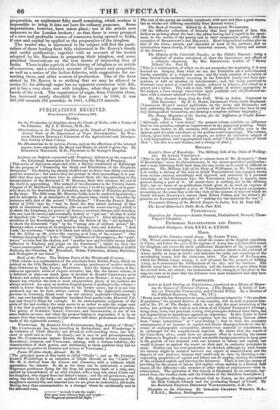DR. BOYLE ON INDIAN ISINGLASS.
IT is probable that neither the housewife who sighs over the high
price of the best isinglass for her blancmange, nor the confectioner who adulterates it or substitutes animal jelly, nor the brewer who
buys an inferior article to fine his beer, nor the calenderer (if the trade yet exists as a distinct business) who is compelled to resort to it to glaze his cottons, knows any thing about what it is or whence it comes. It may therefore be information to say, that isinglass is manufactured from the swimming-bladders or sounds of certain fish. Of these the large sturgeon, caught in several rivers of Russia, furnishes the best, or is the best prepared; selling by wholesale at 10s. to 12s. the pound, whilst the Brazilian or North American only fetches from 2s. Gd. to 3s. 6d., and there are inferior qualities realizing no more than 9d. The value of this seemingly trifling article to Russia may be inferred from the annual imports into England, which vary from 1,800 to 2,000 hundredweight. After an occupation of Calcutta of more than a century and a ter- ritorial possession of Bengal of eighty years, an individual, writing anonymously in a periodical, acquainted the Indian public with the novel facts, not merely that the waters of India produced in plenty fishes that would furnish isinglass, but that a trade in this commodity had long been carried on (it turns out from time im- memorial) between the Indian fishermen and the Chinese, who, (liquorish fellows ! ) not satisfied with the products of the Ganges, ransacked the whole of the Archipelago for parts of fish yielding isinglass, or a gelatinous substance very much akin to it. They have extended their gourmand researches even to Bombay; whence upwards of 5,000 hundredweight of " shark-fins and fish-maws" were exported to China in 1837-8 ; fish-maws, though known by name, being quite unknown in their nature, till Dr. ROTLE, after great difficulty, obtained specimens through the house of FORBES and Co. " On examination, these proved to be composed of a sacklike membrane, which had been split open, of a light colour and semi-transparent, resembling the ordinary qualities of isinglass in appearance." It is also said that the Chinese, after exporting the roughly-cured Ganges isinglass, refine some of it, and reimport it at a large profit. These facts have been ascertained by inquiries instituted since the publication of the anonymous announcement in Parbury's Oriental Herald in 1839. Attention has also been paid to the isinglass it- self: specimens of which have been forwarded to Europe, some prepared under the inspection of Mr. M'CLELAND, of the Bengal Medical service. The less scientifically-prepared samples were valued at Is. 8d. and 4s. per pound ; th prepared under the in- spection of Mr. M'CLELAND produced 7d.; the mere cost of which in India, including the purchase d preparation, was only Is. Id. per pound ; but subsequent expenses, and duties of various kinds, rendered the whole cost threefold the amount realized by the sale. Subjected to scientific analysis, the Indian isinglass differs but little from the Russian. It is of so much less market- value, partly because it is new and the supply uncertain ; partly from the form in which it has been brought to England, which is favourable to adulteration ; but chiefly from want of care in the preparation, an unpleasant fishy smell remaining, which renders it Impossible to bring it into use here for culinary purposes. Some importations, however, have taken place ; nor is the article now unknown to the London brokers ; so that there is every prospect of a new and profitable source of commerce being opened to India, if care and capital he applied to the preparation of the isinglass. The reader who is interested in the subject will find the parti- culars of these leading facts fully elaborated in Dr. ROYLE'S timely and useful publication; together with an account of the modes adopted by the Russians in preparing their isinglass, and some practical observations on the best means of improving that of India. There is also a precis of the history of isinglass as an article of commerce, and a chemical account of its nature and properties, as well as a notice of the Indian fisheries, with suggestions for ex- tending them, and other sources of production. One of the facts stated by Dr. ROYLE is so striking that we may be allowed to notice it ; for although sugar has no apparent connexion with fish, yet it has a very close one with isinglass, when they get into the hands of the cook. The exportation of sugar, from Calcutta alone, has increased nearly threefold in four years : in 1838, it was 587,169 maunds (82 pounds); in 1841, 1,592,173 maunds.



























 Previous page
Previous page